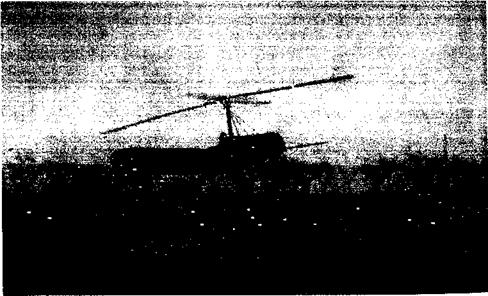Innovation of the Flapping and Lagging Hinges
Based on his many experiments with small models, Cierva noticed that the flexibility of the rattan (palm wood) spars on his models provided different aerodynamic effects compared to the relatively rigid blade structure used on his full-scale machines. This was the key Cierva needed and his “secret of success.” His fourth machine (the C-4), therefore, incorporated blades with mechanical hinges (using horizontal pin joints) at their roots, which allowed the individual blades to flap up and down freely in response to the changing lift forces seen by the blades as they progressed around the shaft axis. Also acting on the blades are drag and centrifugal and gravitational forces, and as a result of free flapping, there are also inertia and Coriolis forces to contend with (see page 197). The blades on the C-4 were restrained by cables attached to the shaft to limit both downward and upward flapping angles and also so the blades would not droop to the ground when the rotor was stopped. Cierva noticed that the incorporation of the flapping hinge eliminated any adverse gyroscopic effects and also allowed the lift forces on the two sides of the rotor to become more equal in forward flight. However, Cierva’s omission of a lead-lag hinge to alleviate the in-plane blade motion from drag and Coriolis forces (resulting from the flapping motion) was an oversight that he would ultimately come to terms with.
In Cierva’s C-4 Autogiro of 1923 (see Fig. 12.6) a single rotor with four independent, freely flapping blades was mounted on a long shaft above an Avro 504 airplane fuselage. The blades were of high aspect ratio, similar to those of modern helicopter blades, and used a relatively efficient Gottingen 429 airfoil shape. A propeller, powered by a Le Rhone engine, provided propulsion. The first version of the C-4 used lateral tilting of the entire rotor disk to provide roll control. However, taxiing tests showed that the control forces involved in tilting the rotor were too high for the pilot and the control response also proved very sluggish. However, the natural tilting of the rotor TPP during flight also tilts the rotor lift
|
Figure 12.6 The Cierva C-4 Autogiro first flew successfully on January 9, 1923. It was the first rotating-wing aircraft to fly and also the first type of heavier-than-air aircraft to fly other than a conventional airplane. |
vector and produces side forces and moments on the autogiro. These must be compensated for by some means to maintain trimmed flight and proper control. On a helicopter, this is done by using cyclic pitch inputs to the blades. But on Cierva’s first machines, the rotor disk was uncontrolled and conventional “fixed-wing” aerodynamic control surfaces (ailerons, elevator, and rudder) were used to provide the necessary forces and moments on the aircraft to compensate for the natural tilting of the rotor disk. While not ideal, Cierva was satisfied with the simplicity of his interim solution to the problem.[45] Cierva’s C-4 Autogiro first flew successfully on January 9, 1923, making a controlled flight in a straight line and covering about 200 m (656 ft) – see Moreno-Caracciolo (1923).
As explained in Chapter 4, the use of a flapping hinge allows each blade to flap up and down independently in a periodic manner with respect to the blade azimuth angle under the action of the varying aerodynamic loads. The blades precess to an equilibrium condition when the local changes in AoA and the aerodynamic loads produced as a result of blade flapping are sufficient to compensate for local changes in the airloads resulting from periodic variations in the dynamic pressure. The flapping response lags the blade pitch (aerodynamic) inputs by about 90° (see Chapter 4, p. 183). Therefore, the main effect of the asymmetry in lift over a rotor with flapping blades is to cause the rotor disk to tilt back, in this case giving it a natural AoA – see Fig. 12.4. In addition, the rotor disk also has a tendency to tilt laterally slightly to the right (for a rotor turning in a counterclockwise direction) because of the coning of the rotor under the action of the lift forces.
On the first lightly loaded Cierva rotor designs, the in-plane forces were balanced by sets of wires connected between the blades, such that as one blade lagged back or forward, the motion was easily resisted by the other blades. However, by Cierva’s own admission [Cierva & Rose (1931)] his early Autogiros were “rather rough in flight owing to a sort of whipping action of the rotor blades which jerked at the mast as they turned in their circle.” Cierva was noticing Coriolis effects, which produce forces in the plane of rotation of the rotor and introduce an important dynamic coupling between flapping (or out-of-plane) motion and the lead-lag (or in-plane) motion of the rotor blades (see page 197).
With later bigger and heavier machines, the combination of higher drag and Coriolis forces produced relatively high cyclic in-plane stresses at the blade root, and flight tests with a C-6 were to show evidence of in-plane structural bending overloads and the onset of fatigue damage. Yet, Cierva initially resisted the use of a second hinge to relieve these Coriolis loads because of weight concerns. Eventually, on a version of the C-6, a blade failed and flew off resulting in the official grounding of all Cierva Autogiros. This episode finally convinced Cierva that another hinge, a lead-lag or “drag hinge,” must be required on the blades – see Fig. 4.1. Cierva tried out the idea of two hinges per blade on his model C-7, and after convincing the authorities of the renewed airworthiness, Cierva went on to develop the C-8 Autogiro. The incorporation of both a flapping hinge and a lead-lag hinge was an important step in the development of the fully articulated rotor hub discussed in Chapter 4, which is used today for many helicopters.













